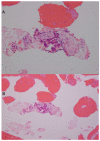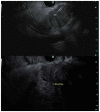The Role of Endoscopic Ultrasonography in the Diagnosis and Staging of Pancreatic Cancer
- PMID: 35326524
- PMCID: PMC8946253
- DOI: 10.3390/cancers14061373
The Role of Endoscopic Ultrasonography in the Diagnosis and Staging of Pancreatic Cancer
Abstract
Pancreatic cancer is the fourth leading cause of cancer-related death and the second gastrointestinal cancer-related death in the United States. Early detection and accurate diagnosis and staging of pancreatic cancer are paramount in guiding treatment plans, as surgical resection can provide the only potential cure for this disease. The overall prognosis of pancreatic cancer is poor even in patients with resectable disease. The 5-year survival after surgical resection is ~10% in node-positive disease compared to ~30% in node-negative disease. The advancement of imaging studies and the multidisciplinary approach involving radiologists, gastroenterologists, advanced endoscopists, medical, radiation, and surgical oncologists have a major impact on the management of pancreatic cancer. Endoscopic ultrasonography is essential in the diagnosis by obtaining tissue (FNA or FNB) and in the loco-regional staging of the disease. The advancement in EUS techniques has made this modality a critical adjunct in the management process of pancreatic cancer. In this review article, we provide an overall description of the role of endoscopic ultrasonography in the diagnosis and staging of pancreatic cancer.
Keywords: endoscopic ultrasonography; loco-regional staging; pancreatic cancer.
Conflict of interest statement
The authors declare no conflict of interest.
Figures









Similar articles
-
Pretherapeutic evaluation of patients with upper gastrointestinal tract cancer using endoscopic and laparoscopic ultrasonography.Dan Med J. 2012 Dec;59(12):B4568. Dan Med J. 2012. PMID: 23290296 Review.
-
[Endoscopy in the diagnosis and staging of pancreatic cancer].Tumori. 1999 Jan-Feb;85(1 Suppl 1):S14-8. Tumori. 1999. PMID: 10235074 Review. Italian.
-
Endoscopic Ultrasound in the Diagnosis and Staging of Pancreatic Cancer.GE Port J Gastroenterol. 2015 Jul 2;22(4):161-171. doi: 10.1016/j.jpge.2015.04.007. eCollection 2015 Jul-Aug. GE Port J Gastroenterol. 2015. PMID: 28868399 Free PMC article. Review.
-
Pancreatic cancer: diagnosis and endoscopic staging.Eur Rev Med Pharmacol Sci. 2010 Apr;14(4):375-85. Eur Rev Med Pharmacol Sci. 2010. PMID: 20496552 Review.
-
Imaging preoperatively for pancreatic adenocarcinoma.J Gastrointest Oncol. 2015 Aug;6(4):343-57. doi: 10.3978/j.issn.2078-6891.2015.024. J Gastrointest Oncol. 2015. PMID: 26261722 Free PMC article. Review.
Cited by
-
Informatics strategies for early detection and risk mitigation in pancreatic cancer patients.Neoplasia. 2025 Feb;60:101129. doi: 10.1016/j.neo.2025.101129. Epub 2025 Jan 21. Neoplasia. 2025. PMID: 39842383 Free PMC article. Review.
-
Imaging of pancreatic ductal adenocarcinoma - An update for all stages of patient management.Eur J Radiol Open. 2024 Feb 8;12:100553. doi: 10.1016/j.ejro.2024.100553. eCollection 2024 Jun. Eur J Radiol Open. 2024. PMID: 38357385 Free PMC article.
-
Multidisciplinary Therapeutic Approaches to Pancreatic Cancer According to the Resectability Status.J Clin Med. 2025 Feb 11;14(4):1167. doi: 10.3390/jcm14041167. J Clin Med. 2025. PMID: 40004698 Free PMC article. Review.
-
A meta-analysis on the efficacy of endoscopic ultrasonography for treatment of pancreatic cancer.Clinics (Sao Paulo). 2024 Mar 28;79:100348. doi: 10.1016/j.clinsp.2024.100348. eCollection 2024. Clinics (Sao Paulo). 2024. PMID: 38552386 Free PMC article.
-
Synchronous Pancreatic Ductal Adenocarcinoma in the Head and Tail, a Double Trouble: A Case Report and Literature Review.Diagnostics (Basel). 2022 Nov 5;12(11):2709. doi: 10.3390/diagnostics12112709. Diagnostics (Basel). 2022. PMID: 36359552 Free PMC article.
References
-
- Pourshams A., Sepanlou S.G., Ikuta K.S., Bisignano C., Safiri S., Roshandel G., Sharif M., Khatibian M., Fitzmaurice C., Nixon M.R., et al. The Global, Regional, and National Burden of Pancreatic Cancer and Its Attributable Risk Factors in 195 Countries and Territories, 1990–2017: A Systematic Analysis for the Global Burden of Disease Study 2017. Lancet Gastroenterol. Hepatol. 2019;4:934–947. doi: 10.1016/S2468-1253(19)30347-4. - DOI - PMC - PubMed
Publication types
LinkOut - more resources
Full Text Sources

